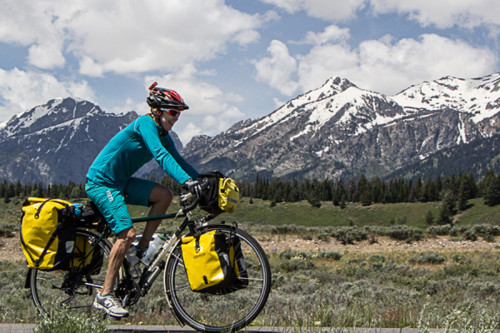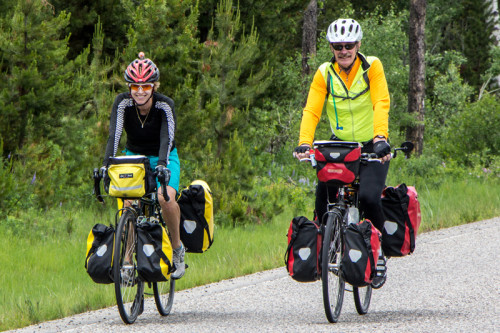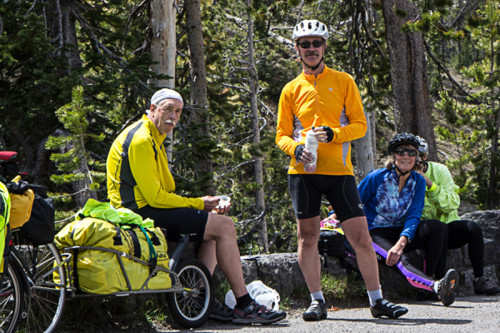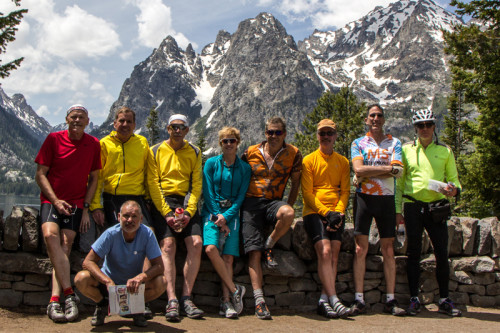By Lou Melini
Over the past 7 years I have done several overnight bike tours with friends from the Wasatch Mountain Club (WMC). From those overnighters I learned that the WMC is the premier bicycle touring organization in Utah. Many of the members have traveled by bike near and far. Early in 2014, WMC members Cheryl Soshnik and Dave Rumbellow told me about a self-supported bike trip through Teton and Yellowstone National Parks planned for the last week of June 2014. Upon hearing about the ride, I decided to move my retirement sooner by one week to join the group. Event leaders Katie Slack and Rusty Gardner had room to accept me, my work agreed to the retirement change, so off I went for my third tour through Teton and Yellowstone National Parks.



right of Rusty – taking a break in a pullout in Yellowstone.
Photos by Robin Perkins.

background.
If you haven’t ridden through Yellowstone on a bike, you should put it on your bucket list. It is simply a beautiful park with a multitude of geological features rarely seen elsewhere in the world. Riding through Yellowstone takes some effort, as you will be above 7500 ft. We crossed the continental divide 4 times, with elevations up to 8300 ft. Due to the elevation you will need to be prepared for varying weather patterns including heat, cold, rain and snow at any time. Riding the roads of Yellowstone is not for all as the shoulders range from adequate to non-existent. Cheryl Soshnik described the road after entering the south entrance of Yellowstone by saying; “We survived the heavy RV traffic, with the poor shoulder section from the South Entrance of Yellowstone to Lewis Lake.” Cheryl’s honest candor is worth noting but overall the riding in Yellowstone is worth the effort for such beauty. North of Lewis Lake until our exit to West Yellowstone the roads do improve. Overall traffic was extremely friendly. There are some dirt trails one could ride to avoid the roads for a short time.
The Yellowstone NP website describes the park as a “Wonderland”. It is an apt description for this park that was established in 1872, the oldest national park in the world. Ulysses S. Grant was President at the time, signing into law the nearly 3,500 sq. miles of park that Congress established. Yellowstone is home to the majority of the world’s geysers. In addition there are numerous and varying geologic features that are simply stunning. In addition there is wildlife such as bison grazing off the side of the roads.
Reservations are difficult to make when traveling long distances by bike. In the National Parks it may prove valuable to make reservations, especially around holidays. Even with nearly 2200 campsites in 12 campgrounds, Yellowstone fills quickly in the summer. Camping in Yellowstone for bicycle travelers has become much easier now that there are Hiker/Biker sites. I remember in 1975 spending an hour or more each day trying to find a friendly camper willing to share a campsite. However there is no guarantee that hiker/biker sites will be available. Grant’s Village has only 3 sites reserved for Hiker/Bikers. If you do not have a reservation, the Parks will do what they can to accommodate a traveling cyclist in my experience.
The Wasatch Mountain Club group started the tour in Jackson, Wyoming after dropping off the vehicles at the Storage Stables, ($5/day). We then rode along a bike path to Teton National Park, camping at Colter Bay. For seniors like myself, I was able to enter Teton NP free with my National Park Senior Pass, a lifetime pass that enables you to enter National Parks plus it grants you half price camping for a one-time $10 fee. Riding along the Teton mountain range was a highlight for some on the ride. Seeing the granite peaks of the Tetons made for a majestic view. After leaving Teton National Park we rode through Yellowstone for another 2 days, exiting in West Yellowstone. We then rode from West Yellowstone along the western side of the Tetons to Victor, Idaho. Most of the group returned to Jackson on day 6 after spending the night in Victor, Idaho utilizing the bike path over Teton Pass. The very experienced bike tourer, Rob Paull and I rode back to Salt Lake City to extend our tour by 5 days.
The total tour as organized was 270 miles. Fifteen cyclists did the ride self-supported. After leaving West Yellowstone we did have rain for half of the next 2 days, the only weather disturbance in otherwise perfect riding conditions. Katie Slack and Rusty Gardner organized the bike tour. They did a fantastic job of providing accommodations for such a large bike-touring group. The group was quite cohesive. Putting little pieces of Swiss chocolate on our sleeping bags would have been the only way for them to have improved on their planning and execution of the ride.
Below is an interview with Katie Slack and Rusty Gardner, the organizers of the trip.
Cycling Utah: Putting on a self-supported bike tour for 15 is quite an undertaking. What sparked your desire to put on a tour?
Rusty: I guess you could call me a tour junkie. I love touring on my bike. It’s great to see the country at a slow, easy pace. I love riding into small towns and meeting people and sharing what I’m doing. I always take any opportunity to introduce others to this lifestyle. Katie and I met in 2013 on a tour through part of western Canada. She was very active in the WMC and wanted to put on a tour and try to introduce more people to touring. She kind of drafted me into assisting her. We talked about several routes and I suggested the Jackson/Teton/Yellowstone route. It’s a route I had previously ridden and was very familiar with.
Katie: I simply wanted to share the joy of bicycle touring with others. But I would never have undertaken this venture without a seasoned partner. I knew Rusty would be ideal because he has so much experience and we work well together.
C.U.: Had the WMC ever put on a tour of this type before?
Rusty: Yes, I believe they have. There have been several self-supported trips in the past. Our goal is to try to increase both the opportunity and numbers for those who would like to tour on a bike.
Katie: The club has sponsored a number of self-supported tours in Utah and neighboring states. These tours are typically organized by a couple of key individuals and the trips are well attended. It’s important to broaden the base of organizers in order to keep interest at a high level and encourage others to organize trips.
C.U.: Both of you have done a bit of touring, Rusty more than Katie from my understanding. What are some of the self-supported tours that you have done?
Rusty: I’ve ridden the Trans-Am route twice (Williamsburg, VA – Florence, OR). Both Trans-Am trips were with an Adventure Cycling Association (ACA) group. I’ve ridden the Northern Tier route (Anacortes, WA – Portland, ME) as a solo self-supported ride. I’ve also toured through Wyoming, Idaho and western Montana on solo rides.
Katie: The only self-supported tour I’ve done previous to this trip was the 2013 Selkirk Loop through British Columbia when I met Rusty. There were 16 riders, including the ACA leader, on that trip.
C.U.: Did your previous touring experience help putting this trip together?
Rusty: Yes! Riding with ACA groups really helped give me some ideas on what would be needed to put on this trip. Helped us define how long the days should be, what we needed to do for camping, what kind of equipment people would need and what kind of training would help riders prepare for the trip.
C.U.: If a reader of this column were to put on a large tour, would it be best for that person to participate in a tour with a lot of other people to gain experience?
Rusty: I would firmly say yes. Managing a ride with 15 others is a challenge. We did a lot of planning, pre-trip scouting and talking to campgrounds to find suitable locations. Unless you’ve seen this type of trip done before, it would be much easier to not take little things and details into consideration. Sometimes you don’t know what you don’t know until you’re really into it. Having ridden in a group tour before really helps you understand the needs and dynamics of a large group ride.
Katie: Rusty nails the point here. I can’t imagine planning a tour for 15—or even 5—if one has never participated in a tour.
C.U.: Did you have a checklist for putting together the Yellowstone tour? If someone reading this column were to do a similar event, what were the, let’s say, top 5 items of consideration for the list?
Rusty: I did not have a checklist. It all came out of my past experience in riding both with groups and solo. Katie and I spent a lot of time discussing issues and trying to make sure everything was covered. The main issues we talked about were: (1) Making up of the group. We wanted to make sure those who went on the trip were prepared with both suitable equipment and had an opportunity to train for the ride. We posted the ride with details saying that each rider needed a “touring bike” and not a standard road bike. This would make sure riders had the proper equipment to make the climbs on this ride. We had grades of 10+% that riders would need to be able to climb. We also posted several training rides to give riders the opportunity to carry their gear and do some on bike training before the start of the trip. (2) We spent a lot of time finding suitable camping for the group. We had two nights in National Parks that really presented a challenge. It is difficult to obtain reservations for large groups in the parks. We did some scouting trips and visited each of the campgrounds we were planning on using. We wanted to make sure that all the campgrounds had all the necessary amenities to support the group. (3) We did a lot of work in Ride With GPS to provide both cue sheets and maps for all the riders. We also had a pre-trip meeting where we went over each riding day using the cue sheets and maps so riders had a good idea of what to expect and any issues or highlights to look for.
Katie: Certainly individual participants should use a checklist for their gear, but a lot of the overall planning is common sense and “layering.” Once we set the route, then we just layered on the logistics of food, water, shelter. As for the top 5 items for consideration, these issues will likely be different for every trip. In our case, we had to find storage for our vehicles. And, because we were riding a popular vacation route in early season conditions at high altitude, we had to choose a timeframe that would maximize our opportunity for decent weather but not overlap too heavily with motor traffic.
C.U.: You set the ride up as a self-supported ride. Did you have any pressure from the WMC or the members to have a SAG vehicle?
Rusty: We purposefully set this ride up as a self-supported ride. We did have one request for a small group to join us with a SAG vehicle and we did turn this request down. We wanted this ride to be totally self-contained. Allowing SAG vehicles changes the complexion of the ride and could have set up two distinct groups within the ride.
Katie: The club sponsors a lot of car camping trips with bikes so yes, there were inquiries from individuals who wanted to bring campers. But adding a SAG vehicle completely changes the dynamics of the trip and we wanted to be self-supported.
C.U.: What were some of the most pleasant surprises on the trip?
Rusty: The most pleasant surprise for me was Day 4 when we left West Yellowstone. The weather took a nasty turn and we found ourselves riding in rain and wind. Despite the poor weather, everyone had a smile on their face and was having a great time. The other real pleasant surprise for me was the ride the last day over Teton Pass. The pass is posted at a 10% gradient but our GPS showed a short stretch at 12%. Most of the riders were very concerned about getting both up and down the pass. I was happy to see everyone safely made it and most of the riders pedaled all the way to the top. Made me glad we did some pre-trip training for everyone.
Katie: I’ll echo what Rusty says and add that the most pleasant surprise for me was the lack of a serious incident, which I think is unusual for a group of this size under these conditions. Everyone finished in good physical and mechanical condition. We did our best to establish expectations and everyone was prepared physically, mentally, and mechanically.
C.U.: Overall how would you say the trip turned out? What, if anything would you have done differently? Would you do this trip again?
Rusty: I thought the trip was a huge success. Every rider I talked to said they had a great time. We had great scenery, mostly good roads, and good weather for 4 of the 6 days. I would lead the same trip again. I’d just make sure we started working on reservations a bit earlier! Got to be a bit nerve racking for a bit when we thought we weren’t going to be able to secure enough campground spots. The only thing I would do differently is making sure our daily mileage stayed around 50-60 miles. We had planned our last day at 72 miles with a 10% gradient pass. We found it was a bit much and as a group we decided to shorten that day and add one day to the trip. A shorter last day worked out much better.
Katie: Only thing I’d change is to add more points of interest to our cue sheets. We noted food & water opportunities along the route, but didn’t have many “must see” stops noted. For example, there were a number of scenic waterfalls that we weren’t aware of. In the future I’d research points of interest so these could be noted on the cue sheet.
C.U.: I understand that the Yellowstone trip was a “warm-up” for a west coast trip? Tell me about the trip-length of time, miles, number of people, and time of the year.
Rusty: Five of us from the Yellowstone trip, Katie, her husband Carl (Kunz), myself, Dave (Rumbellow) and Kevin (Earl) are riding the Pacific Coast Route starting in mid-August. We’ll start in Vancouver, BC and ride north for a loop around the “Sunshine Coast”. We’ll take the ferry back to Anacortes, WA and then ride south down the Pacific Coast Highway (PCH) to San Diego. The trip is right at 2000 miles and we’re projecting 6 weeks to finish. We’re hoping with the late August start that the majority of vacation traffic will be gone from the PCH. I’m really looking forward to riding the coast and seeing what many describe as the most beautiful tour in the United States.
Katie: The Pacific Coast is a totally different approach because we are more flexible on our stops and route. Plus, this is not a club tour. For a trip of this duration it’s important to maintain a small group. I can’t imagine planning a trip of 2000 miles for a group of 15.
C.U.: If someone wanted to get into touring, what is the most important thing they need to look at or think about?
Rusty: I would say their bike. I’ve seen riders trying to tour with a standard road bike and a couple of panniers. It usually doesn’t work very well and they aren’t enjoying themselves. A tour bike is really a hybrid between a road and a mountain bike. Tour bikes need to be a heavier construction to support the additional weight. They also need to be geared like a mountain bike to allow a rider to spin up steep grades carrying everything a rider needs. These two things really dictate the needs of a tour rider. There are a number of stock tour bikes that you see all the time, Surly Long Haul Trucker, Trek 520, Novara Randonee, Co-Motion Americano are four of the most common examples. (Ed. Note: Rusty rides a Long Haul Trucker by Surly; surlybikes.com found at most bicycle shops). If you are looking for a tour bike, I suggest talking to an experienced tour rider and finding a good bike shop that has experience with tour bikes. I would suggest Saturday Cycles or REI. I also know of a great builder of semi-custom tour bikes, Dharma Wheels (Southern Utah).
Katie: It’s all about the bike, so one must be comfortable on the machine. And while I’m an advocate of patronizing your local bike shop, it’s important to note that very few specialize in these hybrid models. In fact, one should expect to order a touring bike after being measured or “fit” for the bike. (Editor’s note: Katie and I both ride custom built Waterford Adventure cycles, Waterfordbikes.com; Waterford also makes Gunnar touring bikes Gunnarbikes.com; sold exclusively by Millcreek Bicycles in Salt Lake City). Except for REI, retailers don’t stock these bikes because they’re a niche product and people like to customize touring bikes to a much greater extent than they would with a road bike. There are many internet resources for researching bikes and gear so that’s always a good place to start. And, as Rusty notes, other tour riders are often the best resource.
Nuts and Bolts:
Know Before You Go: Teton and Yellowstone National Parks.
Teton Camping: 800-628-9988 but the website states campgrounds are on a first-come, first served basis; no reservations except at the group sites at Colter Bay and Gros Ventre.
Reservations: www.YellowstoneNationalParkLodges.com. You could also write to Yellowstone National Park Lodges, PO Box 165, Yellowstone National Park, Wy 82190. If you wish to call for advanced reservations the number is 307-344-7311 or 1-866-439-7375. For same day reservations call 307-344-7901-many of the sites are on a first-come; first served basis including the hiker/biker sites.
Fees: $12 for 7 days entry to either Park. (You should be able to use the same entry pass to enter both Parks given the proximity of the 2 parks.)
Vehicle Storage: Storage Stables Jackson Wy. 888-867-8673; www.storagestables.com
Bus Service: Salt Lake Express with service to Jackson and West Yellowstone: 800-356-9796 or 208-656-8824 (I have not used this service. When I called the customer service representative said there would be a $10 fee for bikes. You should tell customer service when you book your reservation that you are bringing a bike as they will then arrange to pull a trailer for bicycles.)
Yellowstone weather: http://www.weather.com/weather/tenday/Yellowstone+National+Park+WY+WYNPYELL:13
Attractions easily seen by cyclists: Lewis Falls; Norris and West Thumb geyser basins; Old Faithful and Lodge; Upper, midway and lower geyser basins; Firehole Lake drive and the bike trail at Midway Geyser basin; Lower and upper falls and Gibbon falls; Mammoth Hot Springs.

